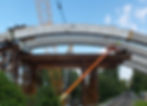Meeting Bridges Where They Are
- Brooks McKinney, APR
- Aug 7
- 10 min read
Updated: Aug 15
Structural engineer Daniel Baxter advises state and local transportation agencies on how best to repair, rehabilitate or replace aging highway bridge infrastructure.

As long as he can remember, Daniel Baxter has been fascinated with bridges. Growing up in Southeast Michigan in the 1980s, he loved building bridges with toy blocks. When he was in second grade, his parents, eager to support his interest in urban infrastructure, surprised him with an HO-scale model train set, which they set up in the family’s basement playroom.
“We set about building a city and elevated highways to cross the railroad tracks and carry traffic around the city,” Baxter recalls. “I guess you could call it my first exposure to structural engineering.”
It was also his first lesson in designing bridges that can withstand environmental, structural and human-induced hazards.
“I came home one day to discover that a section of my HO-scale elevated highway had collapsed and was just sitting on the city street below, smushed on top of my little HO-scale plastic cars,” Baxter says. He learned from his mom that a repairman working in their home had bumped the bridge sideways with his toolbox, causing it to fall.
“In modern engineering speak, my elevated highway didn’t have sufficient lateral load resistance,” he explains. “When I rebuilt the bridge structure in my model city, I made sure that it did.”

Bridging to Reality
Today, as a regional bridge technical manager in the Minneapolis office of Michael Baker International, Baxter is helping ensure that highway bridges across Minnesota and the Great Lakes region continue to meet the long-term functional, financial, and, at times, emotional needs of the communities they serve. Bridges are integral to the interstate highway system used by cars and trucks to transport goods and services nationwide.
Baxter supports a 10-person team that engages primarily in the analysis, design, and/or rehabilitation of bridges many of which include pedestrian facilities, i.e., separate, integrated pathways for people walking or using mobility aids. Throughout his career, he’s also worked on freight railroad bridges, a few light rail structures and several pedestrian- and bicycle-only bridges.
“Many of the bridges we work on were built in the 1960s for the Interstate Highway System or the infrastructure that feeds into it,” Baxter observes. “Our key challenge is determining for bridge owners—typically state departments of transportation—the best strategy for maintaining a bridge as part of the transportation system. Is it better to rehabilitate it and extend its life—most bridges have a design life of at least 75 years—or simply replace it with something new?”
Taking the High Road
Baxter was born and raised in Ann Arbor, Mich. His mom taught remedial math to students in local elementary and middle schools. His dad, a university English professor, taught creative writing classes, first at Wayne State University, later at the University of Michigan.

“I grew up in a fairly literary household, one that was quite removed from structural engineering,” Baxter deadpans. “I witnessed a lot of competitive Scrabble among my parents and their friends, but not much in the way of number crunching.”
But he knew what he liked, and that was bridges. When he had to define a free-form math project during his sophomore year of high school, a friend of his mom’s—a civil engineer who knew about Baxter’s interest in bridges—suggested that he analyze the forces at play in a truss bridge, whose load-bearing structure comprises a series of interconnected triangles.
“He loaned me a couple of college structural analysis textbooks and I was able to figure it out,” Baxter declares proudly. “The exercise convinced me that (bridge design) was something I might be good at.”
Celebrating the Journey
Bridges also played a recurring role in Baxter family summer vacations to the North Shore of Lake Superior.
To reach their family cabin, the Baxters would drive up through the Lower Peninsula of Michigan to Mackinaw City, cross the Mackinac Bridge to the Upper Peninsula, then drive west to Duluth, Minn. and Lake Superior.

“For me, the Mackinac Bridge always represented the start of summer vacation,” reflects Baxter. “To this day, it remains one of my favorite bridges.”
Trusting His Instincts
College took Baxter to Carleton College in Northfield, Minn., in the fall of 1997. He knew he wanted to study engineering, but he also liked the dual-degree engineering programs—and much smaller class sizes—offered by Carleton.
After his junior year at Carleton, Baxter was unsure whether he still wanted to pursue the dual-degree engineering program. His uncertainty vanished, however, during the family’s annual road trek to Minnesota.
“As we drove to Mackinaw City, I was listening to the album Up by R.E.M, one of my favorite bands,” he remembers. “The last song on the album, ‘Falls to Climb,’ came on just as we started to cross the Mackinac Bridge. Something about how the music worked together with the bridge convinced me that ‘Yeah, this is definitely what I should do.’”

Trusting his instincts, Baxter earned a B.A. in physics from Carleton in 2001, followed by a B.S. in civil engineering and a M.S. in structural engineering from Washington University (WashU) in St. Louis in 2003.
Building a Foundation
Baxter’s years at WashU also laid the foundation for his enduring professional interest in concrete bridges (pre-stressed and post-tensioned), arch bridges, steel truss bridges and 3D bridge modeling. During the summer and fall of 2002, for example, he served as a materials testing intern with the Missouri Department of Transportation (MoDOT), where he witnessed the production and casting of concrete segments for a new Highway 364 bridge across Creve Coeur Lake just west of St. Louis.

“I loved the simplicity and functional elegance of the bridge, which is called a balanced cantilever concrete segmental bridge,” Baxter declares.
Crossing Over
That bridge would also become the inspiration for a senior bridge design project that helped Baxter and some of his WashU classmates win the Undergraduate Student Paper Competition at the 2003 International Bridge Conference. The win also earned them an all-expenses paid trip to the conference, which, serendipitously, became the bridge to Baxter’s future.
“At the conference, I ran into John Dietrick, a long-time employee of Michael Baker, who advised me that the company was going to be working soon on a concrete segmental bridge and a segmental concrete arch bridge in Cleveland,” Baxter notes. “He encouraged me to apply for a current (engineering job) opening, which I did. And that’s how I ended up at Michael Baker.”
Baxter started with the company in January 2004, and has been with them ever since.

Learning the Bridge Spans
For the next 10 years, Baxter worked in the Cleveland office of Michael Baker helping design projects such as the Route 52 segmental bridge near Ocean City, N.J. and the Fulton Road Bridge Replacement in Cleveland, which featured six spans of precast concrete arches post-tensioned together after assembly.
In 2014, when Michael Baker decided to open a new office in Minneapolis, it tapped Baxter to lead the effort. For Baxter, it was a no-brainer.
“My dad is originally from Minneapolis, my parents moved here from Ann Arbor in 2003, and my wife’s parents live seasonally in the Twin Cities,” he reveals. “My wife and I were trying to get a little closer to family so the opportunity with Michael Baker lined up nicely with our personal goals.”
Laying Out Options
Today, Baxter works on a variety of bridge projects including load ratings, bridge rehabilitations and designs for new bridges (often to replace existing structures). Load rating projects assess a bridge’s capacity in its current condition to carry dynamic loads such as vehicle traffic. Baxter and his team counsel clients on the benefits and relative costs of repairing, rehabilitating or replacing a bridge.

Repair involves fixing specific, localized damage or deterioration to restore a bridge to its original or near-original condition. Rehabilitation, by contrast, involves upgrading or modifying major parts of the bridge to restore its structural integrity, meet current standards and extend its lifespan.
Listening to the Community
Sometimes, Baxter reflects, what’s best for a bridge is what’s best for the community.
From 2016 to 2019, he and his team worked on rehabilitating the Winona Bridge, an iconic, 75-year-old structure that crosses the Mississippi River between Winona, Minn. and Fountain City, Wis.

To satisfy Minnesota’s latest bridge safety requirements, Baxter and his team proposed a design that added internal redundancy to the tension members of the truss bridge: if any part of a built-up member fractured, there would still be enough additional material to keep the overall member in place.
“By adding internal redundancy, our design extended the bridge’s service life by 50 years while preserving a historical and emotional icon for people of Winona,” he emphasizes.
Fighting Gravity with Technology
So what causes bridges to deteriorate? In Baxter’s experience, it’s often salt-contaminated water created by putting down salt to melt ice on bridge and roadways.
“The salty water leaks through a roadway’s expansion joints or gets splashed over the side of the bridge onto structural elements,” he theorizes. “The chloride (salt) in the water eats away at the bridge’s concrete and steel.”
While this effect occurs most often in northern climates, it has inspired bridge designers nationwide to focus on minimizing the number of expansion joints (used to accommodate the thermal expansion of a road surface) on bridge decks.

“Many bridges designed in the 1960s used ‘simple spans’ with expansion joints at every span on the bridge deck because it was easy to determine the forces acting on the bridge elements,” Baxter explains. “Modern structural analysis tools allow us to understand with much more precision the impacts of concrete expansion and contraction, which allows us to design much longer continuous structures with far fewer expansion joints.”
A great example of this technology advance, he adds, is the Fulton Road Bridge Replacement in Cleveland. Opened in 2010, the bridge is 1568 feet long but only uses expansion joints at each end of the structure.
Working on the Run
For Baxter, workdays begin before dawn in the three-bedroom house in the Longfellow neighborhood of South Minneapolis that he shares with his wife, two school-aged children and a “somewhat cantankerous” 15-year-old green cheek conure (parrot) named Penny.

Like many of his neighbors, he commutes the six miles to downtown Minneapolis by freeway. Baxter’s “freeway,” however, is the West River Parkway Trail, a bicycling and pedestrian walkway that runs along the Mississippi River just a few blocks from his home.
Four or five days per week, he either runs to work—it typically takes him about 45-50 minutes—or he commutes by bicycle or public transit to work, then runs home.
Most days he’s out the door by 5:30 a.m., arriving at his desk, showered and ready for the day by 7:00 a.m.
Delivering Confidence
In his office, Baxter meets daily with team members to review progress on multiple ongoing bridge design and analysis projects, either as a team leader or as an advisor.
“I always try to emphasize the importance of understanding our calculations and erring on the side of quality, even if that means exceeding a project budget or extending a deadline,” he notes.
Most of Baxter’s work takes place in the office, but he also meets periodically with bridge project teams in other Michael Baker field offices. He’s also been known to do project “research” during his morning runs along the Mississippi.
“During a recent run to work, I took photos of a railroad bridge for a conceptual design study we’re working on,” Baxter reveals. “Accessing the best vantage points for the photos required some ‘trail running’ through a gorge below my normal route.”
Putting Family First
When he’s not running or managing bridge projects, Baxter enjoys family vacations, reading, attending events at his kids’ elementary school and “reminiscing” on an electronic keyboard.
“I’ve played keyboards in several bands over the years,” he explains. “I’m not in a band currently but the guitar player in my college band and high school band is moving to Minneapolis later this year. I hope we’ll be able to play music together again.”
Serving Travelers Nationwide
In the meantime, Baxter is focused on ensuring the long-term durability and reliability of bridges in Minnesota and the Great Lakes region.

“In the end, my colleagues at Michael Baker, our bridge clients and I all want the same thing,” he emphasizes, “safe, well-designed bridges that reflect the functional, financial and aesthetic standards of the communities they serve. I’m proud to be part of a team that prioritizes those goals every day.”
# # #
If you enjoyed this profile, please share a link to the story with your friends, family and colleagues at work. If you have other great bridge stories to share or if you'd like to suggest other people who should be featured on this blog, please send your ideas to me at brooks@personsofinfrastructure.com. Many thanks.



